Physical Address
304 North Cardinal St.
Dorchester Center, MA 02124
Tendons are connective tissues that connect muscle to bone. They are instrumental in transmitting forces generated by muscle to move bones and joints. Tendon injuries are relatively common throughout the world and can significantly affect hand function. Various methods for tendon repair have been described. The optimal approach for surgical repair depends on the location of injury and type of tendon involved. Post-operative rehabilitation is essential to optimize functional outcome. Early active motion post-operative protocols prevent tendon adhesions.
Tendons are dense connective tissues that connect muscle to bone. Tendons transmit forces generated by muscles to move joints. Tendon injuries most commonly occur in the hand. These injuries typically result from a sharp cut or crush injury but can occasionally occur as closed injuries.
There are 12 flexor tendons in the hand and forearm. The flexor digitorum superficialis (FDS) and flexor digitorum profundus (FDP) are the finger flexor tendons ( Fig. 2.3.1 ). The flexor pollicis longus (FPL) is the flexor tendon of the thumb. These flexor tendons travel beneath the transverse carpal ligament. The flexor carpi radialis (FCR), flexor carpi ulnaris (FCU), and palmaris longus (PL) are the flexors of the wrist. The PL is absent in approximately 15% to 20% of the general population.
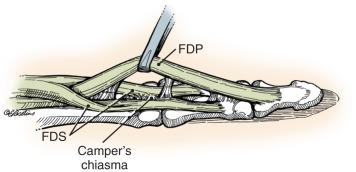
The most intricate portions of the flexor tendons are within the digits. Here, the tendons glide within a closed fibro-osseous tendon sheath, forming a closed synovial compartment extending from the distal palm to the middle of the distal phalanx. This sheath contains an inner layer of paratenon that covers the tendons to enable smooth tendon gliding and provides nutrition to the tendon. Pulleys are intermittent fibrous condensations that exist along the tendon sheath to secure the tendon to the adjacent bone. The pulley system is an integral part of the digital flexor sheath. This unique system consists of annular pulleys and cruciate pulleys that maintain the anatomical paths of the tendons close to the phalanges to optimize mechanical efficiency of digital flexion ( Fig. 2.3.2 ). There are five annular pulleys and three cruciate pulleys. The annular pulleys are numbered from A1 through A5. The A2 and A4 pulleys, on the proximal and middle phalanges, respectively, are particularly dense and rigid. The integrity of the A2 and A4 pulleys is critical to prevent bow-stringing. The three cruciate pulleys are collapsible and allow for digital flexion to occur without significant distortion to the annular pulleys.
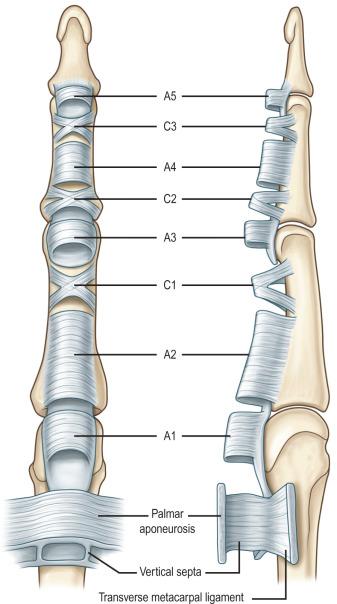
The FDS tendon is located superficial to the FDP proximally from the forearm to the palm ( ). At the proximal aspect of the flexor tendon sheath, the FDS bifurcates and wraps around the FDP tendon. The two slips of the FDS tendons then are rejoined deep to the FDP, forming Camper's chiasm, at the level of the distal proximal phalanx. The FDS then inserts onto the volar middle phalanx. The FDP inserts onto the volar distal phalanx.
Injuries to the flexor tendons can be classified by zone ( Fig. 2.3.3 ). This classification system helps the surgeon assess the injury and formulate the treatment plan. Zone 1 consists of the area of the volar hand located distal to the insertion of the FDS tendon on the middle phalanx. Zone 2, also known as “no man's land,” extends from the proximal aspect of the A1 pulley in the palm to the FDS tendon insertion. It is here where the FDS and FDP tendons interweave in a complex manner. Zone 3 covers the area from the distal aspect of the transverse carpal ligament to the proximal A1 pulley. Zone 4 is the area spanning the transverse carpal ligament. Zone 5 encompasses the area proximal to the proximal aspect of the transverse carpal ligament. The thumb has its own classification distinct from the other digits. The thumb tendon sheath consists of only the FPL tendon. Zone 1 of the thumb is the area distal to the thumb interphalangeal joint. Zone 2 consists of the area from the A1 pulley to the interphalangeal joint, and zone 3 is located over the thenar eminence.
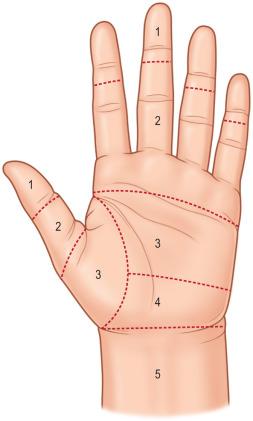
The extensor tendons are different from the flexor tendons ( Fig. 2.3.4 ). The extensor tendons are not confined within a fibro-osseous tunnel. These tendons also become thin and flat distally over the phalanges. The extensor mechanism consists of extrinsic muscles located on the forearm, intrinsic muscles located at the level of the metacarpals, and fibrous structures. The extrinsic tendons pass through one of six distinct anatomical compartments of the extensor retinaculum on the dorsal wrist ( Fig. 2.3.5 and ). Distal to the extensor retinaculum, the extensor digitorum communis (EDC) tendons to the index, middle, ring, and small fingers are interconnected by juncturae tendinum located at the level of the metacarpals. These connections facilitate combined extension of the fingers. The index and small fingers have additional individual extensor tendons in addition to the slips from the EDC tendon. On the dorsal digits, the extensor tendons split up into a central slip and two lateral bands ( Fig. 2.3.6 ). These merge with the intrinsic extensor system to form the digital complex extensor apparatus. The central slip inserts onto the dorsal base of the middle phalanx. The conjoined lateral bands come together over the middle phalanx and continue on distally as the terminal tendon.
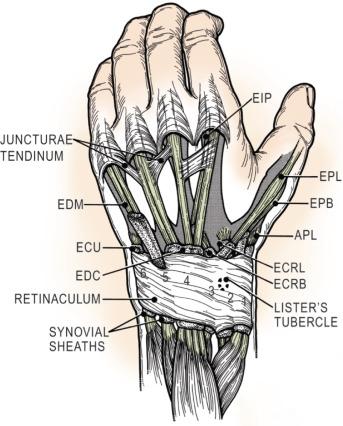
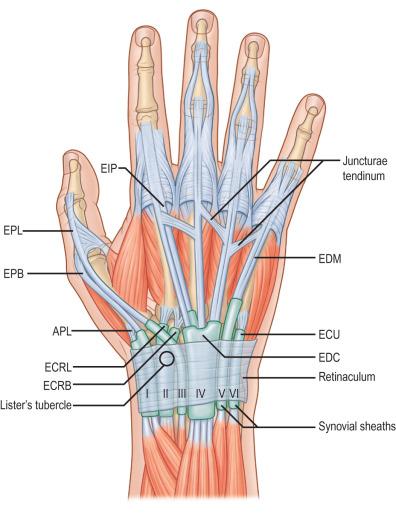
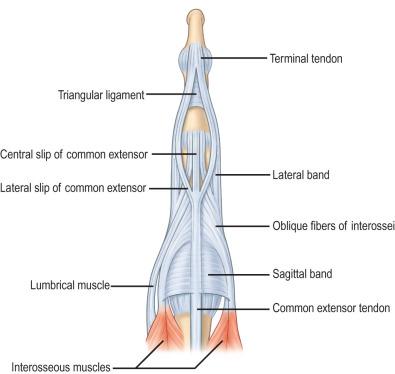
As with flexor tendons, injuries to the extensor tendon mechanism are classified by anatomical zone ( Fig. 2.3.7 ). Zone 1 injuries are located at the distal interphalangeal joint and distal phalanx. Zone 2 consists of the area over the middle phalanx. Zone 3 spans the proximal interphalangeal joint and includes the insertion of the central slip. Zone 4 consists of the proximal phalanx. Zone 5 is located over the metacarpophalangeal joints. Zone 6 consists of the area over the metacarpals in the dorsal hand. Zone 7 is directly over the extensor retinaculum. Zone 8 is the area between the extensor retinaculum and the musculotendinous junction. Zone 9 is located in the proximal forearm.
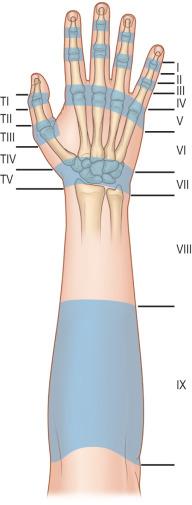
Solicitation of the patient's history and the mechanism of injury provide helpful information regarding the extent of the tendon injury as well as concomitant injuries. A physical examination is critical. The natural resting posture of the injured digits is assessed for abnormalities. For example, complete laceration of both the FDP and FDS tendons is readily diagnosed when the injured digit is seen in a relatively extended position with loss of active finger flexion at the interphalangeal joints ( Fig. 2.3.8 ).
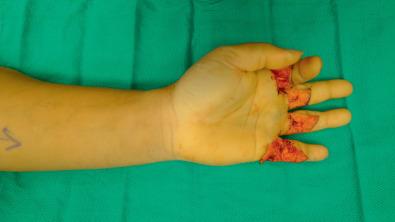
The neurovascular status of the digits should be assessed to evaluate for concomitant injury to the neurovascular bundle running along the sides of the digits ( Fig. 2.3.9 ). Emergent surgical repair is indicated in the setting of digital nerve or artery laceration. Radiographs should be obtained for open injuries to evaluate for fractures or foreign bodies.
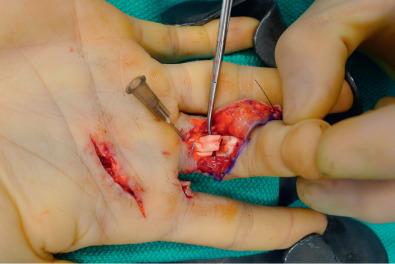
In the setting of acute injury to tendons, comprehensive debridement and exploration of the injured area must be performed immediately. This ensures a detailed assessment of the extent of injury.
Tendon injuries resulting in partial tendon lacerations can be managed with wound care alone and early range of motion. However, this may be complicated by gap formation at the tendon injury site and lead to a poor functional outcome.
Complete tendon injury is treated with surgical repair. Many surgical techniques have been described. The type of repair utilized depends on the acuity of the injury, location of the injury, and type of tendon involved (flexor tendon versus extensor tendon). Open wounds associated with the injury should be debrided immediately. For an acute tendon injury, the repair should be performed within days to a couple of weeks after the injury. The rationale for early tendon repair is to minimize tendon adhesion and loss of tendon gliding. Early post-operative tendon movement also facilitates tendon healing via the longitudinal forces.
The goal of tendon repair is to provide the best tendon stability while minimizing tendon shortening. Tendons are generally repaired with a core suture and an epitendinous circumferential running suture. 3-0 and 4-0 sutures are commonly used for core sutures and 5-0 sutures for epitendinous sutures. Many different core suture techniques have been described ( Fig. 2.3.10 ). The most classically used core suture is the Kessler suture. Locking stitches, as seen in the Kessler suture, help prevent suture pull-out and reduce gapping.
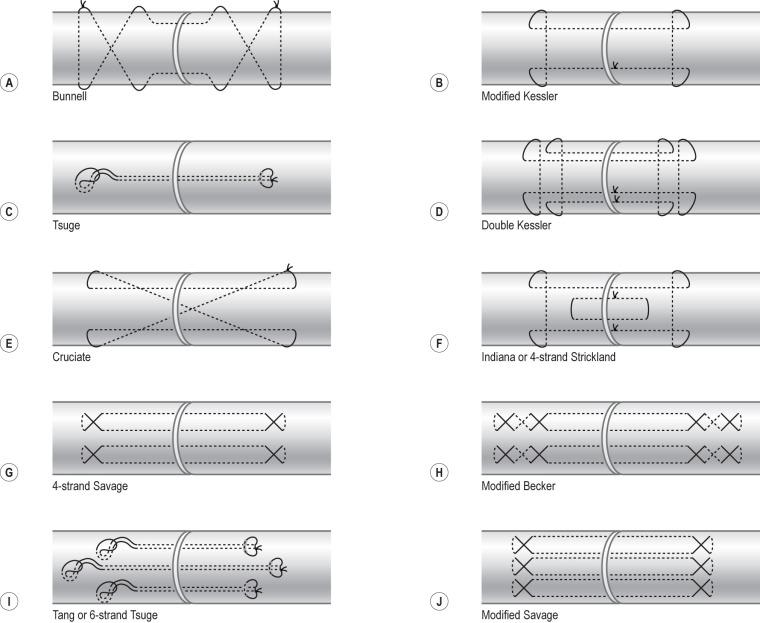
Become a Clinical Tree membership for Full access and enjoy Unlimited articles
If you are a member. Log in here